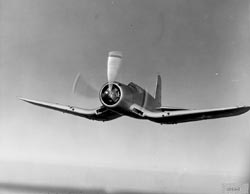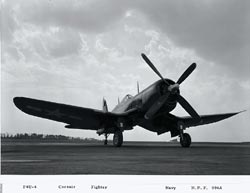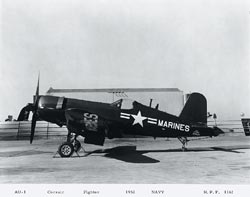|
 Designed in 1938 and first flown in 1940, Corsairs first tasted combat at Guadalcanal. It was at the ‘Canal that Corsairs definitely established their aerial superiority over the vaunted Japanese Zero, a highly maneuverable aircraft that had previously outperformed all U. S. fighters. Designed in 1938 and first flown in 1940, Corsairs first tasted combat at Guadalcanal. It was at the ‘Canal that Corsairs definitely established their aerial superiority over the vaunted Japanese Zero, a highly maneuverable aircraft that had previously outperformed all U. S. fighters.
The Corsair was the first American fighter to top 400 miles an hour and the first to house a 2,000 horsepower engine. The gull wing Corsairs were the toughest foe faced by enemy pilots. Interrogation of high Japanese brass at the end of the war disclosed the fact that they considered the Corsair the top fighter in use by any opposing service in the Pacific.
From Guadalcanal, spearheading the drive toward Tokyo, Corsairs took part in nearly every major campaign in the Pacific. Known to the Japanese as ‘whistling death' and to its Marine pilots as the “Sweetheart of Okinawa,” the Corsair also made aerial history in areas other than the Pacific. Among them: the Indian Ocean and the North Sea.
 Corsairs were flown in combat by the U. S. Marines, U S Navy, the Royal Navy and the New Zealand Air Force. The name Corsair became synonymous with the names of Marine and Navy Aces like Lt. Col. Gregory (Pappy) Boyington, Lt. Ken Walsh, Lt. Bob Hansen, CDR Tommy Blackburn, Lt. Ira (ike) Kepford, and a host of others. The most famous pilot to take the Corsair into action was Col. Charles A.Lindbergh. In one attack on Wotje Atoll he took off in a Corsair with a bomb load of 4,000 pounds which was the heaviest ever carried up to that time by a single-engine fighter. Corsairs were flown in combat by the U. S. Marines, U S Navy, the Royal Navy and the New Zealand Air Force. The name Corsair became synonymous with the names of Marine and Navy Aces like Lt. Col. Gregory (Pappy) Boyington, Lt. Ken Walsh, Lt. Bob Hansen, CDR Tommy Blackburn, Lt. Ira (ike) Kepford, and a host of others. The most famous pilot to take the Corsair into action was Col. Charles A.Lindbergh. In one attack on Wotje Atoll he took off in a Corsair with a bomb load of 4,000 pounds which was the heaviest ever carried up to that time by a single-engine fighter.
In the course of shooting down 2,140 enemy aircraft, only 189 Corsairs were lost in combat - a ratio of better than 11 to one. From February 13, 1942, when a handful of Corsairs first engaged the Japanese at Guadalcanal, until V-J Day Corsairs carried out a total of 64,051 action sorties. Of this total, 54, 470 were flown from land bases and 9,58l from the decks of aircraft carriers.
The end of WWII and the advent of jets spelled the finish of most Propeller driven fighters. Not so for the Corsair. From 1946 until 1950, Corsairs were the top fighters in the two big U. S. Fleets, the Sixth and Seventh. When the jets finally “came aboard” the Navy didn’t eliminate the versatile Corsairs, they just assigned them another equally important role, that of low altitude attack aircraft.
Meanwhile, by way of pointing up the fact that the old girl still had plenty of life left in her, Corsairs placed one-two in the grueling Thompson Trophy event at the Cleveland Air Races in 1947. Cook Cleland, the winner, broke the closed course record with an average speed of 396.13 miles an hour. Again, in 1949, Corsairs triumphed, placing one, two, three.
 When war flamed in Korea, the Corsairs were ready. Assigned primarily to the low-altitude, fighter-bomber phase of the action, they were on familiar ground, flying close air support missions in support of ground troops, a function they helped pioneer in World War II. When war flamed in Korea, the Corsairs were ready. Assigned primarily to the low-altitude, fighter-bomber phase of the action, they were on familiar ground, flying close air support missions in support of ground troops, a function they helped pioneer in World War II.
In 1952 the last of the Corsair line, designated the F4U-7, was delivered to the French under terms of the Mutual Defense Assistance Program making it the last piston powered fighter aircraft to be produced in the United States. Even though Corsair production finally reached a halt with the delivery of these 94 F4U-7s, Corsairs continued to see service for many years thereafter.
F4U:
Operation Summary - WWII
WWII Record
WWII Top Corsair Aces
The Fighting 17 (VF-17)
Production
Operational Summary Post WWII
|